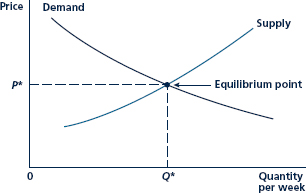
Intermediate Microeconomics and Its Application 12th Edition by Walter Nicholson,Christopher Snyder
Edition 12ISBN: 978-1133189022
Intermediate Microeconomics and Its Application 12th Edition by Walter Nicholson,Christopher Snyder
Edition 12ISBN: 978-1133189022 Exercise 26
The equilibrium price in problem is P = 3. This is an equilibrium because at this price, quantity demanded is precisely equal to quantity supplied (Q = 500). One might ask how the market is to reach this equilibrium point. Here we look at two ways:
a. Suppose an auctioneer calls out prices (in dollars per gallon) in whole numbers ranging from $1 to $5 and records how much orange juice is demanded and supplied at each such price. He or she then calculates the difference between quantity demanded and quantity supplied. You should make this calculation and then describe how the auctioneer will know what the equilibrium price is.
b. Now suppose the auctioneer calls out the various quantities described in problem. For each quantity, he or she asks, "What will you demanders pay per gallon for this quantity of orange juice?" and "How much do you suppliers require per gallon if you are to produce this much orange juice?" and records these dollar amounts. Use the information from problem to calculate the answers that the auctioneer will get to these questions. How will he or she know when an equilibrium is reached?
c. Can you think of markets that operate as described in part a of this problem? Are there markets that operate as described in part b? Why do you think these differences occur?
Problem Marshall defined an equilibrium price as one at which the quantity demanded equals the quantity supplied.
a. Using the data provided in problem, show that P = 3 is the equilibrium price in the orange juice market.
b. Using these data, explain why P = 2 and P = 4 are not equilibrium prices.
c. Graph your results and show that the supply demand equilibrium resembles that shown in Figure.
d. Suppose the demand for orange juice were to increase so that people want to buy 300 million more gallons at every price. How would that change the data in problem? How would it shift the demand curve you drew in part c?
e. What is the new equilibrium price in the orange juice market, given this increase in demand? Show this new equilibrium in your supply demand graph.
f. Suppose now that a freeze in Florida reduces orange juice supply by 300 million gallons at every price listed in problem. How would this shift in supply affect the data in problem? How would it affect the algebraic supply curve calculated in that problem?
g. Given this new supply relationship together with the demand relationship shown in problem, what is the equilibrium price in this market?
h. Explain why P = 3 is no longer an equilibrium in the orange juice market. How would the participants in this market know P = 3 is no longer an equilibrium?
i. Graph your results for this supply shift.
Figure The Marshall Supply-Demand Cross
a. Suppose an auctioneer calls out prices (in dollars per gallon) in whole numbers ranging from $1 to $5 and records how much orange juice is demanded and supplied at each such price. He or she then calculates the difference between quantity demanded and quantity supplied. You should make this calculation and then describe how the auctioneer will know what the equilibrium price is.
b. Now suppose the auctioneer calls out the various quantities described in problem. For each quantity, he or she asks, "What will you demanders pay per gallon for this quantity of orange juice?" and "How much do you suppliers require per gallon if you are to produce this much orange juice?" and records these dollar amounts. Use the information from problem to calculate the answers that the auctioneer will get to these questions. How will he or she know when an equilibrium is reached?
c. Can you think of markets that operate as described in part a of this problem? Are there markets that operate as described in part b? Why do you think these differences occur?
Problem Marshall defined an equilibrium price as one at which the quantity demanded equals the quantity supplied.
a. Using the data provided in problem, show that P = 3 is the equilibrium price in the orange juice market.
b. Using these data, explain why P = 2 and P = 4 are not equilibrium prices.
c. Graph your results and show that the supply demand equilibrium resembles that shown in Figure.
d. Suppose the demand for orange juice were to increase so that people want to buy 300 million more gallons at every price. How would that change the data in problem? How would it shift the demand curve you drew in part c?
e. What is the new equilibrium price in the orange juice market, given this increase in demand? Show this new equilibrium in your supply demand graph.
f. Suppose now that a freeze in Florida reduces orange juice supply by 300 million gallons at every price listed in problem. How would this shift in supply affect the data in problem? How would it affect the algebraic supply curve calculated in that problem?
g. Given this new supply relationship together with the demand relationship shown in problem, what is the equilibrium price in this market?
h. Explain why P = 3 is no longer an equilibrium in the orange juice market. How would the participants in this market know P = 3 is no longer an equilibrium?
i. Graph your results for this supply shift.
Figure The Marshall Supply-Demand Cross

Explanation
(a). Here, as we know that the excess de...
Intermediate Microeconomics and Its Application 12th Edition by Walter Nicholson,Christopher Snyder
Why don’t you like this exercise?
Other Minimum 8 character and maximum 255 character
Character 255



